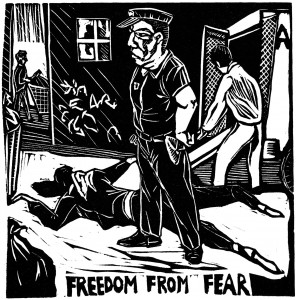Black Youth, Police Violence, and Daily ‘Urban Hassles’
I’ve mentioned before that I am working on a lot of police related projects at this time. In fact, my organization is basically focusing on issues of police violence through 2012 and likely beyond. One of the main reasons for this is because the young people who we interact with want to talk about the police. This is a ubiquitous topic of conversation. Yet I am not feeling particularly well-equipped to offer anything transformational to the youth. It is not enough to address the “problem” without also providing some historical context for it as well as thinking through a way out of the police state.
So we are embarking on several projects that we hope will provide us with a better way to engage with young people around conversations about the police. We have launched a new participatory action research project called “Chain reaction: alternatives to calling the police.” We are working on a wiki project about Chicago police brutality and I am working on developing a curriculum about the history of police violence.
I was at a restorative justice conference in Madison, Wisconsin for most of the past week. I learned about a new measure called the “urban hassles scale” which is a tool to assess the daily hassles experienced by urban minority youth. An article that presents the scale offers some definitions of urban hassles:
“Lazarus (1984) defined daily hassles as “experiences and conditions of daily living that have been appraised as salient and harmful or threatening to the endorser’s well-being” (p. 376). Hassles have also been defined in the literature as irritating, frustrating everyday experiences arising from the transactions between the individual and the environment (Kanner, Coyne, Schaefer, & Lazarus, 1981).”
You can imagine how excited I was at discovering this scale. Evaluation is a major part of the work that we do at my organization. It is always easier and better for us if we can find validated measures that we can use in our evaluation tools. So as soon as I returned from Madison last night, I went in search of the “urban hassles scale.” Here are the components of the scale:
1. Take different routes home to keep safe
2. Pressured by friends to join a gang
3. Made fun of because of grades
4. Worried that someone will try to take your clothes, shoes, or money
5. Pressured to carry weapon for protection
6. Must work to help pay bills at home
7. Nervous about gunshots/sirens at night
8. Keeping your fear about safety secret from your friends
9. Offered sex by drug addicts for money
What is GLARINGLY missing from this list of measures? THE POLICE, of course… It is absolutely inconceivable to me that researchers could ignore one of the single most detrimental stressors in the lives of urban youth of color. This is another indictment of academia in my opinion. It underscores the huge gap between theory and practice. I say this as someone who has one foot in academia herself. Just listen to these young people of color describing their experiences of being “stopped and frisked” by the police.
This is the epitome of an “urban hassle.” Someone really needs to revise the scale in order for it to be credible. In the meantime, we will use it while making sure to add something about young people’s relationship to the police (in order to make sure that it reflects their lived realities).
Note: By the way, since I have worked with girls for so many years, I would also add a measure about street harassment and heterosexist public harassment to the scale.

